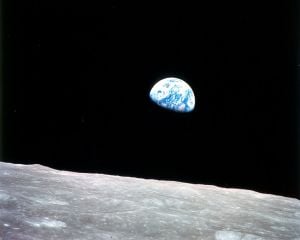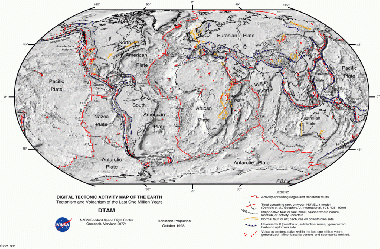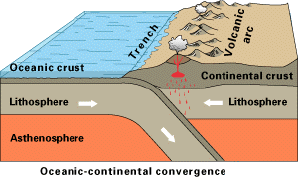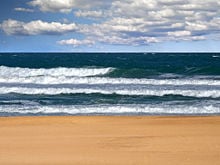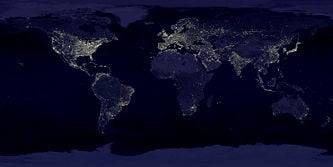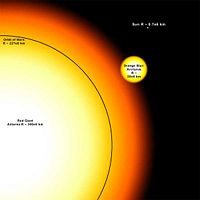Difference between revisions of "Earth" - New World Encyclopedia
(→Land use: editing) |
(→Human geography: editing) |
||
| Line 250: | Line 250: | ||
2,481,250 km<sup>2</sup> (1993 est.) | 2,481,250 km<sup>2</sup> (1993 est.) | ||
| − | === | + | === Environmental hazards === |
| − | + | Many places experience natural hazards such as [[hurricane]]s, [[earthquake]]s, [[landslide]]s, [[tsunami]]s, [[volcano|volcanic eruptions]], [[tornado]]es, [[sinkhole]]s, [[blizzard]]s, [[flood]]s, [[drought]]s, and other calamities. In addition, large areas are subject to human-made [[pollution]] of the air and water, loss of vegetation ([[overgrazing]], [[deforestation]], [[desertification]]), loss of [[wildlife]], [[species]] [[extinction]], [[soils retrogression and degradation|soil degradation]], soil depletion, [[erosion]], and introduction of [[invasive species]]. There is also concern about [[global warming]], based on a "greenhouse effect" caused by increasing [[carbon dioxide]] emissions, and this subject is the focus of intense study and debate. | |
| − | |||
| − | |||
| − | |||
| − | |||
=== Human geography === | === Human geography === | ||
{{main|Human geography}} | {{main|Human geography}} | ||
[[Image:Earthlights dmsp.jpg|333px|thumb|right|Earth at night, composite of pictures taken between October 1994 and March 1995.]] | [[Image:Earthlights dmsp.jpg|333px|thumb|right|Earth at night, composite of pictures taken between October 1994 and March 1995.]] | ||
| − | Earth has approximately 6,500,000,000 human inhabitants ([[February 24]] [[2006]] estimate). | + | The Earth has approximately 6,500,000,000 human inhabitants ([[February 24]] [[2006]] estimate). |
<ref name="LiveScience"> | <ref name="LiveScience"> | ||
{{cite news | {{cite news | ||
| Line 275: | Line 271: | ||
Projections indicate that the [[world population|world's human population]] will reach seven billion in 2013 and 9.1 billion in 2050 (2005 [[United Nations|UN]] estimates). Most of the growth is expected to take place in [[developing nations]]. Human [[population density]] varies widely around the world. | Projections indicate that the [[world population|world's human population]] will reach seven billion in 2013 and 9.1 billion in 2050 (2005 [[United Nations|UN]] estimates). Most of the growth is expected to take place in [[developing nations]]. Human [[population density]] varies widely around the world. | ||
| − | It is estimated that only one eighth of the surface | + | It is estimated that only one-eighth of the Earth's surface is suitable for [[human]]s to dwell on. Three-quarters of the surface is covered by [[ocean]]s, and half the land area is [[desert]], high [[mountain]]s, or other unsuitable terrain. |
| − | The northernmost settlement in the world is | + | The northernmost settlement in the world is Alert, Nunavut, on [[Ellesmere Island]] in [[Canada]]. The southernmost is the [[Amundsen-Scott South Pole Station]] in [[Antarctica]], almost exactly at the [[South Pole]]. |
| − | There are 267 administrative divisions, including nations, dependent areas, other | + | There are 267 administrative divisions, including nations, dependent areas, and other miscellaneous entries. Earth does not have a [[sovereignty|sovereign]] [[government]] with planet-wide authority. Independent sovereign [[nation]]s claim all the land surface except for some segments of [[Antarctica]]. Although there is a general international organization, the [[United Nations]], it is primarily a discussion forum with only limited ability to pass and enforce [[international law]]s. |
| − | In total, about four hundred people have been outside the Earth's atmosphere as of [[2004]], and of these, | + | In total, about four hundred people have been outside the Earth's atmosphere as of [[2004]], and of these, 12 have walked on the [[Moon]]. (''See [[space exploration]].'') |
== Descriptions of Earth == | == Descriptions of Earth == | ||
Revision as of 20:57, 23 May 2006
- For other uses, see Earth (disambiguation).
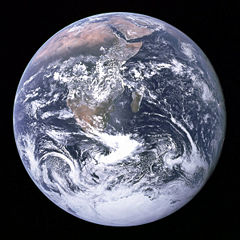
| |
| The Blue Marble, taken from Apollo 17 | |
| Orbital characteristics (Epoch J2000) | |
|---|---|
| Aphelion | 152,097,701 km (1.016 710 333 5 AU) |
| Perihelion | 147,098,074 km (0.983 289 891 2 AU) |
| Semi-major axis | 149,597,887.5 km (1.000 000 112 4 AU) |
| Semi-minor axis | 149,576,999.826 km (0.999 860 486 9 AU) |
| Orbital circumference | 924,375,700 km (6.179 069 900 7 AU) |
| Orbital eccentricity | 0.016 710 219 |
| Sidereal orbit period | 365.256 366 d (1.000 017 5 a) |
| Synodic period | n/a |
| Max. orbital speed | 30.287 km/s (109,033 km/h) |
| Average orbital speed | 29.783 km/s (107,218 km/h) |
| Min. orbital speed | 29.291 km/s (105,448 km/h) |
| Orbital inclination to ecliptic | 0 (7.25° to Sun's equator) |
| Longitude of the ascending node | 348.739 36° |
| Argument of the perihelion | 114.207 83° |
| Satellites | 1 (the Moon) (see also 3753 Cruithne) |
| Physical characteristics | |
| Aspect Ratio | 0.996 647 1 |
| Ellipticity | 0.003 352 9 |
| Radius: | |
| Equatorial | 6,378.137 km |
| Polar | 6,356.752 km |
| Mean | 6,372.797 km |
| Diameter: | |
| Equatorial | 12,756.274 km |
| Polar | 12,713.504 km |
| Mean | 12,745.594 km |
| Circumference: | |
| Equatorial | 40,075.02 km |
| Meridional | 40,007.86 km |
| Mean | 40,041.47 km |
| Surface Area | 510,065,600 km² |
| Land | 148,939,100 km² (29.2 %) |
| Water | 361,126,400 km² (70.8 %) |
| Volume | 1.083 207 3×1012 km³ |
| Mass | 5.9742×1024 kg |
| Density | 5,515.3 kg/m³ |
| Equatorial surface gravity | 9.7801 m/s² (0.997 32 g) |
| Escape velocity | 11.186 km/s |
| Sidereal rotation period | 0.997 258 d (23.934 h) |
| Rotational velocity (at the equator) |
465.11 m/s |
| Axial tilt | 23.439 281° |
| Right ascension of North pole |
0° (0 h 0 min 0 s) |
| Declination | 90° |
| Albedo | 0.367 |
| Surface temperature - min - mean - max |
185 K (-88 °C) 287 K (14 °C) 331 K (58 °C) |
| Surface pressure | 100 kPa |
| Adjective | Earthling, Terrestrial, Terran |
| Atmospheric constituents | |
| nitrogen | 77 % |
| oxygen | 21 % |
| argon | 1 % |
| carbon dioxide | 0.038% |
| water vapor | trace (varies with climate) |
Earth (often referred to as "The Earth") is the third planet in the solar system in terms of distance from the Sun, and the fifth in order of size. It is the largest of its planetary system's terrestrial planets and the only place in the universe currently known to support life. Scientists estimate that the Earth was formed around 4.57 billion (4.57×109)[1] years ago (see Age of the Earth) and its largest natural satellite, the Moon, began orbiting it shortly thereafter, around 4.533 billion years ago. Since its formation, the Earth has been transformed through geologic and biological processes, so that any traces of the original conditions have been virtually eliminated.
The Earth's outer surface, or crust, is divided into several tectonic plates that gradually migrate across the surface over geologic time spans. The interior of the planet remains active, with a thick layer of molten mantle and an iron core that generates a magnetic field. The atmospheric conditions have been significantly altered by the presence of life forms, which create an ecological balance that modifies the surface conditions. About 70% of the surface is presently covered in salt water oceans, and the remainder consists of continents and islands.
There is significant interaction between the Earth and its environment in space. The relatively large Moon provides ocean tides and has gradually modified the length of the planet's rotation period. A cometary bombardment during the early history of the planet is believed to have formed the oceans. Later, asteroid impacts are understood to have caused significant changes to the surface environment. Changes in the planet's orbit may also be responsible for the ice ages that have covered significant portions of the surface in glacial sheets.
Lexicography
Terms that refer to the Earth can use the Latin root terra-, such as the word terrestrial. There is also the alternative Latin root tellur-, as used in words such as telluric, tellurian, tellurion and Tellurium. Both terms derive from the Roman goddess Terra Mater, who was also called by the presumably more ancient name Tellūs Mater. Scientific terms such as geography, geocentric and geothermal use the Greek prefix geo-, derived from Terra Mater's Greek counterpart Gaia.
The English word "earth" has cognates in many modern and ancient languages. Examples in modern tongues include aarde in Dutch and Erde in German. The root also has cognates in extinct languages such as ertha in Old Saxon and ert (meaning "ground") in Middle Irish, derived from the Old English eorðe. All of these words are derived from the Proto-Indo-European base *er-. Given metathesis, we can find cognates of "earth" between terra and the modern Romance languages, for instance tierra in Spanish or terra in Portuguese.
Several Semitic languages have words for "earth" similar to those in Indo-European languages, although evidence of a link is not overwhelming. Arabic has aard; Akkadian, irtsitu; Aramaic, araa; Phoenician, erets (which appears in the Mesha Stele); and Hebrew, ארץ (arets, or erets when followed by a noun modifier).
Symbol
The astrological and astronomical symbol for Earth consists of a circled cross, the arms of the cross representing a meridian and the equator (⊕). A variant puts the cross atop the circle (♁).
History
Based on the available evidence, scientists have been working to reconstruct some of the details of our planet's past. Earth is believed to have formed around 4.55 billion years ago out of a gaseous cloud called the "solar nebula," along with the Sun and other planets. The Moon formed soon after. Initially molten, the outer layer of the planet cooled, resulting in the solid crust. Outgassing and volcanic activity produced the primordial atmosphere; condensing water vapor, augmented by ice delivered by comets, produced the oceans.[2] Scientists speculate that a self-replicating molecule may have been formed around 4 billion years ago, and that the last common ancestor of all life may have existed half a billion years later.[3]
With the development of photosynthetic organisms, the Sun's energy could be harvested directly. As a result, oxygen accumulated in the atmosphere and gave rise to the ozone layer.[4] With the ozone layer absorbing harmful ultraviolet radiation, life forms were able to colonize the Earth's surface.
It is thought that over hundreds of millions of years, the continents have migrated across the surface of the Earth, occasionally combining to form a supercontinent and then breaking apart. Roughly 750 million years ago (mya), the earliest known supercontinent, Rodinia, began to break up. The continents later recombined to form Pannotia, 600-540 mya, then finally Pangaea, which broke apart 180 mya.[5]
Since the 1960s, it has been hypothesized that severe glacial action between 750 and 580 million years ago, during the Neoproterozoic, covered much of the planet in a sheet of ice. This hypothesis has been termed "Snowball Earth," and it is of particular interest as it precedes the Cambrian explosion when multicellular lifeforms began to proliferate.[6]
Since the Cambrian explosion, about 535 million years ago, there were five distinct mass extinctions.[7] The last one occurred 65 million years ago, when a meteorite collision is thought to have triggered the extinction of the (non-avian) dinosaurs and other large reptiles, but spared small animals such as mammals, which seem to have resembled shrews. Over the last 65 million years, mammalian life diversified.
Once humans appeared, they transformed the Earth in a short timespan like no other life form had before. Humans have affected both the nature and quantity of other life forms as well as global climate.
Physical characteristics
Earth is the largest and densest of the "inner" planets of the solar system, that is, the planets within the asteroid belt. When viewed from outer space, much of the Earth has a deep blue and white appearance, caused by the oceans and clouds in the atmosphere. It has an albedo (measure of light reflectivity) of 36.7%, which is exceeded only by Venus among the inner planets.
Geology
The Earth's shape is that of an oblate spheroid, with an average diameter of approximately 12,742 km.[8] The planet's curvature is visible from some regions on the surface such as the Bonneville Salt Flats in the United States. The Earth consists of the atmosphere, hydrosphere, crust, mantle, and core. The biosphere is a small layer in this composition and is usually not considered part of the physical layers of the Earth.
The geologic component layers of the Earth[9] are located at the following depths below the surface:
| Depth | Layer | |
|---|---|---|
| Kilometers | Miles | |
| 0–60 | 0–37 | Lithosphere (locally varies between 5 and 200 km) |
| 0–35 | 0–22 | Crust (locally varies between 5 and 70 km) |
| 35–60 | 22–37 | Uppermost part of mantle |
| 35–2890 | 22–1790 | Mantle |
| 100–700 | 62–435 | Asthenosphere |
| 2890–5100 | 1790–3160 | Outer core |
| 5100–6378 | 6378–3954 | Inner core |
Atmosphere
The Earth's atmosphere protects and sustains life forms by absorbing ultraviolet solar radiation, moderating temperature extremes, transporting water vapor, and providing useful gases. It contains about 78% nitrogen, 21% oxygen, and trace amounts of other gases such as carbon dioxide and water vapor.
Magnetic field
The Earth's magnetic field is shaped roughly as a magnetic dipole, with the poles currently located proximate to the planet's geographic poles. The field forms the "Magnetosphere," which shields the Earth's surface by deflecting charged particles coming from the solar wind. The collision between the magnetic field and solar wind forms what are called the "Van Allen radiation belts," which are a pair of concentric, torus-shaped regions of energetic charged particles. When the plasma (composed of charged particles) enters the Earth's atmosphere at the magnetic poles, it produces a phenomenon called the Aurora.
Earth in the solar system
It takes the Earth, on average, 23 hours, 56 minutes, and 4.091 seconds (1 sidereal day) to rotate around the axis connecting the north pole and the south pole. From Earth, the main apparent motion of celestial bodies in the sky (except meteors, which are within the atmosphere, and low-orbiting satellites) is the movement to the west at a rate of 15 °/h (= 15'/min), that is, a Sun or Moon diameter every two minutes.
Earth orbits the Sun every 365.2564 mean solar days (1 sidereal year). From Earth, this gives an apparent movement of the Sun with respect to the stars at a rate of about 1 °/day, that is, a Sun or Moon diameter every 12 hours, eastward. The Earth's orbital speed averages about 30 km/s (108,000 km/h), which is enough to cover one Earth diameter (~12,600 km) in 7 minutes, and one distance to the Moon (384,000 km) in 4 hours.
Earth has one natural satellite, the Moon, which revolves with the Earth around a common barycenter, from fixed star to fixed star, every 27.32 days. When combined with the Earth-Moon system's common revolution around the Sun, the period of the synodic month, from new moon to new moon, is 29.53 days.
Viewed from Earth's north pole, the motion of Earth, its moon and their axial rotations are all counterclockwise. The orbital and axial planes are not precisely aligned: Earth's axis is tilted some 23.5 degrees against the Earth-Sun plane. This tilt causes the seasons). Also, the Earth-Moon plane is tilted about 5 degrees against the Earth-Sun plane—otherwise, there would be an eclipse every month.
In modern times, the Earth reaches its perihelion (when the planet is nearest to the Sun) about January 3, and its aphelion (when it is farthest from the Sun) about July 4 (near the solstices, which are on about December 21 and June 21).
The Moon
| Name | Diameter (km) | Mass (kg) | Semi-major axis (km) | Orbital period |
|---|---|---|---|---|
| Moon | 3,474.8 | 7.349×1022 | 384,400 | 27 Days, 7 hours, 43.7 minutes |
The Moon, sometimes called "Luna," is a relatively large satellite that is structurally similar to a terrestrial planet. The Moon's diameter is about one-quarter that of the Earth. The natural satellites orbiting other planets are called "moons," after the Earth's Moon. With the exception of Pluto's Charon, it is the largest moon in the solar system relative to the size of its planet.
The gravitational attraction between the Earth and Moon causes the tides on Earth. The same attraction has led to the phenomenon known as tidal locking: The Moon's rotational period is the same as the time it takes to orbit the Earth. As a result, the Moon always presents the same face to the planet. As the Moon orbits Earth, different parts of its face are illuminated by the Sun, leading to the lunar phases: The dark part of the face is separated from the light part by what is called the "solar terminator."
Due to a phenomenon called tidal acceleration, the Moon recedes from Earth at a rate of approximately 38 millimeters (mm) per year. The Earth's day also lengthens by about 17 microseconds (µs) every year. Over millions of years, these tiny modifications can add up to significant changes. During the Devonian period, for example, there were 400 days in a year, with each day lasting 21.8 hours.
The Moon may dramatically affect the development of life by taming the weather. Paleontological evidence and computer simulations show that Earth's axial tilt is stabilized by tidal interactions with the Moon.[10] Some theorists believe that, without this stabilization against the torques applied by the Sun and planets to the Earth's equatorial bulge, the rotational axis might be chaotically unstable, as it appears to be with Mars. If Earth's axis of rotation were to approach the plane of the ecliptic (plane of the Earth's orbit around the Sun), seasonal differences could become extreme, resulting in extremely severe weather. One pole would be pointed directly toward the Sun during summer and directly away during winter. Planetary scientists who have studied the effect claim that this might kill all large animal and higher plant life.[11] This remains a controversial subject, however, and further studies of Mars—which shares Earth's rotation period and axial tilt, but not its large moon or liquid core—may provide added insights.
The Sun is 400 times larger than the Moon, but the Moon is 400 times closer to the Earth than the Sun. Consequently, we can observe total eclipses and annular eclipses from the Earth.
The most widely accepted theory of the Moon's origin, the "giant impact hypothesis," states that it was formed from the collision of a Mars-size protoplanet with the early Earth. This hypothesis explains (among other things) the Moon's relative lack of iron and volatile elements, and the fact that its composition is nearly identical to that of the Earth's crust.
The Earth does not have another natural orbiting body other than the Moon, although the asteroid Cruithne has been erroneously described as such. Cruithne was discovered in 1986 and follows an elliptical orbit around the Sun at about the same average orbital radius as the Earth. However, from the point of view of the moving Earth, Cruithne follows a horseshoe orbit around the Sun that avoids close proximity with the Earth.
Geographical statistics
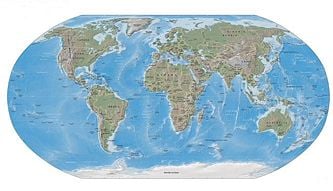
Area:[12]
- Total surface area: 510.072 million km2
- Land: 148.94 million km2
- Water: 361.132 million km2
- Note: 70.8% of the world's surface is covered by water, 29.2% is exposed land
Total water volume:
1.4 × 109 km3, of which 2.5% is freshwater.[13]
Land boundaries:
The land boundaries in the world total 250,472 km[12] (not counting shared boundaries twice)
Coastline:
356,000 km.[12] (Figures from different sources vary substantially, depending on precision of measurements, tides, and so forth.)
Maritime claims: (see United Nations Convention on the Law of the Sea)
- Contiguous zone: 24 nautical miles (44 km) claimed by most, but can vary
- Continental shelf: 200 m depth claimed by most or to depth of exploitation; others claim 200 nautical miles (370 km) or to the edge of the continental margin
- Exclusive fishing zone: 200 nautical miles (370 km) claimed by most, but can vary
- Exclusive economic zone: 200 nautical miles (370 km) claimed by most, but can vary
- Territorial sea: 12 nautical miles (22 km) claimed by most, but can vary
- Note: boundary situations with neighboring states prevent many countries from extending their fishing or economic zones to a full 200 nautical miles (370 km)
- 42 nations and other areas are completely landlocked (see list of landlocked countries)
Plate tectonics
Plate tectonics (from the Greek word τεκτων, tektoon, meaning "one who constructs and destroys") is a theory of geology developed to explain the phenomenon of "continental drift."
The outermost part of the Earth's interior is made up of the lithosphere, consisting of the crust and the solidified uppermost part of the mantle. Below the lithosphere lies the asthenosphere, which consists of the weak (or soft) zone of the upper mantle. The mantle behaves like a superheated, extremely viscous liquid.
According to the theory of plate tectonics, the lithosphere is broken up into what are called tectonic plates, which essentially "float" on the asthenosphere. These plates move in relation to one another. Earthquakes, volcanic activity, mountain-building, and oceanic trench formation occur along plate boundaries.
Plate tectonic theory arose out of two separate geological observations: continental drift, noticed in the early twentieth century, and seafloor spreading, noticed in the 1960s. The theory itself was developed during the late 1960s and has since been accepted by virtually all scientists. The theory has revolutionized the earth sciences and is valued for its unifying and explanatory power for diverse geological phenomena. As such, it is comparable to the development of the periodic table for chemistry and quantum mechanics in physics, or the discovery of the genetic code for biology.
Environment and ecosystem
Earth is the only place in the universe where life is absolutely known to exist. The various life forms on Earth are sometimes said to form a biosphere.
The biosphere is divided into a number of biomes, inhabited by broadly similar flora and fauna. On land, biomes are separated primarily by latitude. Terrestrial biomes lying within the Arctic and Antarctic Circles are relatively barren of plant and animal life, while most of the more populous biomes lie near the Equator.
Climate
The most prominent features of the Earth's climate are its two large polar regions, two narrow temperate zones, and a wide, equatorial, tropical to subtropical region. Precipitation patterns vary widely, ranging from several meters of water per year to less than a millimeter per year.
Ocean currents are important factors in determining climate, particularly the spectacular "thermohaline circulation" (the density-driven circulation of the oceans), which distributes heat energy from the equatorial oceans to the polar regions.
Terrain
The Earth's terrain can vary greatly from place to place. Only about 30% of the Earth's surface consists of dry land, while the remainder is covered with water. The exposed land has mountains, deserts, plains, plateaus, and so forth.
Currently, the total arable land is 13.31% of the land surface, with only 4.71% supporting permanent crops.[12] Close to 40% of the Earth's land surface is presently used for cropland and pasture, or an estimated 3.3 × 109 acres of cropland and 8.4 × 109 acres of pastureland.[14]
Extremes of elevation
Elevation extremes: (measured relative to sea level)
- Lowest point on land: Dead Sea −417 m
- Lowest point overall: Challenger Deep of the Mariana Trench in the Pacific Ocean −10,924 m [15]
- Highest point: Mount Everest 8,844 m (2005 est.)
Natural resources
- The Earth's crust contains large deposits of fossil fuels, including coal, petroleum, natural gas, methane clathrate. We tap these deposits for energy production and as feedstock for chemical production.
- Mineral ore bodies have been formed in the Earth's crust by the action of erosion and plate tectonics. These bodies form concentrated sources for many metals and other useful elements.
- Earth's biosphere produces many useful biological products, including (but not limited to) food, wood, pharmaceuticals, oxygen, and many recycled organic wastes.
- The land-based ecosystem depends upon topsoil and fresh water, and the oceanic ecosystem depends upon dissolved nutrients washed down from the land.
Some of these resources, such as mineral fuels, are difficult to replenish over a short time scale. They are therefore called non-renewable resources. The exploitation of non-renewable resources by humans has become a subject of significant controversy.
Land use
- Arable land: 13.13%[12]
- Permanent crops: 4.71%[12]
- Permanent pastures: 26%
- Forests and woodland: 32%
- Urban areas: 1.5%
- Other: 30% (1993 est.)
Irrigated land: 2,481,250 km2 (1993 est.)
Environmental hazards
Many places experience natural hazards such as hurricanes, earthquakes, landslides, tsunamis, volcanic eruptions, tornadoes, sinkholes, blizzards, floods, droughts, and other calamities. In addition, large areas are subject to human-made pollution of the air and water, loss of vegetation (overgrazing, deforestation, desertification), loss of wildlife, species extinction, soil degradation, soil depletion, erosion, and introduction of invasive species. There is also concern about global warming, based on a "greenhouse effect" caused by increasing carbon dioxide emissions, and this subject is the focus of intense study and debate.
Human geography
The Earth has approximately 6,500,000,000 human inhabitants (February 24 2006 estimate). [16] Projections indicate that the world's human population will reach seven billion in 2013 and 9.1 billion in 2050 (2005 UN estimates). Most of the growth is expected to take place in developing nations. Human population density varies widely around the world.
It is estimated that only one-eighth of the Earth's surface is suitable for humans to dwell on. Three-quarters of the surface is covered by oceans, and half the land area is desert, high mountains, or other unsuitable terrain.
The northernmost settlement in the world is Alert, Nunavut, on Ellesmere Island in Canada. The southernmost is the Amundsen-Scott South Pole Station in Antarctica, almost exactly at the South Pole.
There are 267 administrative divisions, including nations, dependent areas, and other miscellaneous entries. Earth does not have a sovereign government with planet-wide authority. Independent sovereign nations claim all the land surface except for some segments of Antarctica. Although there is a general international organization, the United Nations, it is primarily a discussion forum with only limited ability to pass and enforce international laws.
In total, about four hundred people have been outside the Earth's atmosphere as of 2004, and of these, 12 have walked on the Moon. (See space exploration.)
Descriptions of Earth
Earth has often been personified as a deity, in particular a goddess (see Gaia and Mother Earth). The Chinese Earth goddess Hou-Tu is similar to Gaia, the deification of the Earth. As the patroness of fertility, her element is Earth. In Norse mythology, the Earth goddess Jord was the mother of Thor and the daughter of Annar. Ancient Egyptian mythology is different than that of other cultures because Earth is male, Geb, and sky is female, Nut.
Although commonly thought to be a sphere, the earth is actually an oblate spheroid. It bulges slightly at the equator and is slightly flattened at the poles. In the past there were varying levels of belief in a flat Earth, but ancient Greek philosophers and, in the Middle Ages, thinkers such as Thomas Aquinas believed that it was spherical.
A 19th-century organization called the Flat Earth Society advocated the even-then discredited idea that the Earth was actually disc-shaped, with the North Pole at its center and a 150-foot (50 meter) high wall of ice at the outer edge. It and similar organizations continued to promote this idea, based on religious beliefs and conspiracy theories, through the 1970s. Today, the subject is more frequently treated tongue-in-cheek or with mockery.
Prior to the introduction of space flight, these inaccurate beliefs were countered with deductions based on observations of the secondary effects of the Earth's shape and parallels drawn with the shape of other planets. Cartography, the study and practice of mapmaking, and vicariously geography, have historically been the disciplines devoted to depicting the Earth. Surveying, the determination of locations and distances, and to a somewhat lesser extent navigation, the determination of position and direction, have developed alongside cartography and geography, providing and suitably quantifying the requisite information.
The technological developments of the latter half of the 20th century are widely considered to have altered the public's perception of the Earth. Before space flight, the popular image of Earth was of a green world. Science fiction artist Frank R. Paul provided perhaps the first image of a cloudless blue planet (with sharply defined land masses) on the back cover of the July 1940 issue of Amazing Stories, a common depiction for several decades thereafter. [17] Apollo 17's 1972 "Blue Marble" photograph of Earth from cislunar space became the current iconic image of the planet as a marble of cloud-swirled blue ocean broken by green-brown continents. A photo taken of a distant Earth by Voyager 1 in 1990 inspired Carl Sagan to describe the planet as a "Pale Blue Dot". [18] Earth has also been described as a massive spaceship, with a life support system that requires maintenance, or as having a biosphere that forms one large organism. See Spaceship Earth and Gaia theory.
In the fictional Hitchhiker's Guide To The Galaxy, Earth's entire entry consists of a single word — "harmless" — emphasizing its insignificance in the cosmos. Later in the eponymous science fiction series, this humbling consideration is alleviated slightly when the entry is updated to read "mostly harmless". The Earth is also a computer to search for the Ultimate Question of Life, the Universe and Everything.
Earth's future
The most probable cause for the Earth's destruction will take place when the Sun as part of its solar lifespan, expands to a Red Giant. Current models predict that the Sun will expand out to about 99% of the distance to the Earth's present orbit (1 Astronomical Unit, or AU). However by that time the orbit of the Earth will expand to about 1.7 AUs due to mass loss by the Sun, and so the planet will escape envelopment.[19] This event is estimated to take place in 5 billion years. (5 Gyr).
Before reaching the Red Giant stage, however, the luminosity of the Sun will continue to steadily increase. It will grow from the current luminosity by 10% in 1.1 Gyr and up to 40% in 3.5 Gyr.[19] Climate models show that a steady increase in radiation reaching the Earth are likely to have dire consequences, including possible loss of the oceans.[20]
See also
| Subtopic | Links |
|---|---|
| Astronomy | Darwin (ESA) · Terrestrial Planet Finder |
| Ecology | Millennium Ecosystem Assessment |
| Economy | World economy |
| Fiction | Hollow Earth · Journey to the Center of the Earth · Destruction of Earth · Earth in fiction |
| Geography, Geology |
Degree Confluence Project · Earthquake · Extremes on Earth · Plate tectonics · Equatorial bulge |
| History | Geologic time scale · Human history · Origin and evolution of the solar system · Timeline of evolution |
| Law | International law |
| Mapping | Google Earth · World Wind |
| Politics | List of countries |
ReferencesISBN links support NWE through referral fees
- NASA's Earth fact sheet
- Discovering the Essential Universe (Second Edition) by Neil F. Comins (2001)
- space.about.com - Earth - Pictures and Astronomy Facts
Notes
- ↑ G.B. Dalrymple, 1991, "The Age of the Earth", Stanford University Press, California, ISBN 0-8047-1569-6.
- ↑ A. Morbidelli et al, 2000, "Source Regions and Time Scales for the Delivery of Water to Earth", Meteoritics & Planetary Science, vol. 35, no. 6, pp. 1309-1320.
- ↑ W. Ford Doolitte, "Uprooting the Tree of Life", Scientific American, Feb. 2000.
- ↑ L. V. Berkner, L. C. Marshall, 1965, "On the Origin and Rise of Oxygen Concentration in the Earth's Atmosphere", Journal of the Atmospheric Sciences, Vol. 22, No. 3, pp. 225–261.
- ↑ J.B. Murphy, R.D. Nance, "How do supercontinents assemble?", American Scentist, vol. 92, pp. 324-333.
- ↑ J.L. Kirschvink, 1992, "Late Proterozoic Low-Latitude Global Glaciation: The Snowball Earth", The Proterozoic Biosphere, pp 51-52.
- ↑ D. Raup & J. Sepkoski, 1982, "Mass extinctions in the marine fossil record", Science, vol. 215, pp. 1501–1503.
- ↑ "Geodetic Reference System 1980 (GRS80)", XVII General Assembly, International Association of Geodesy.
- ↑ T. H. Jordan, "Structural Geology of the Earth's Interior", Procedings National Academy of Science, 1979, Sept., 76(9): 4192–4200.
- ↑ Laskar, J., Robutel, P., Joutel, F., Gastineau, M., Correia, A.C.M., Levrard, B., 2004, "A long term numerical solution for the insolation quantities of the Earth", Astronomy and Astrophysics, 428, pp. 261-285.
- ↑ Williams, D.M., J.F. Kasting, 1997, "Habitable planets with high obliquities", Icarus 129, 254-268.
- ↑ 12.0 12.1 12.2 12.3 12.4 12.5 CIA: The World Factbook, "World".
- ↑ Shiklomanov, Igor A. 1993, "World fresh water resources", In Water in crisis: A guide to the world's fresh water resources, ed. Peter H. Gleick, 13–24. New York: Oxford University Press, ISBN 0195076273.
- ↑ FAO, 1995, "United Nations Food and Agricultural Organization Production Yearbook", 49.
- ↑ "Deep Ocean Studies". Ocean Studies. RAIN National Public Internet and Community Technology Center. Retrieved 2006-04-02.
- ↑ David, Leonard, "Planet's Population Hit 6.5 Billion Saturday", Live Science, 2006-02-24. Retrieved 2006-04-02.
- ↑ Ackerman, Forrest J (1997). Forrest J Ackerman's World of Science Fiction. Los Angeles: RR Donnelley & Sons Company, 116-117. ISBN 1-57544-069-5.
- ↑ Pale Blue Dot. SETI@home. Retrieved 2006-04-02.
- ↑ 19.0 19.1 I.J. Sackmann, A.I. Boothroyd, K.E. Kraemer, "Our Sun. III. Present and Future.", Astrophysical Journal, vol. 418, pp. 457.
- ↑ J.F. Kasting, 1988, "Runaway and Moist Greenhouse Atmospheres and the Evolution of Earth and Venus", Icarus, 74, pp. 472-494.
External links
- USGS Geomagnetism Program
- Overview of the Seismic Structure of Earth
 PDF
PDF - NASA Earth Observatory
- Beautiful Views of Planet Earth Pictures of Earth from space
- Java 3D Earth's Globe
- Projectshum.org's Earth fact file (for younger folk)
| |||
|---|---|---|---|
| The Sun · Mercury · Venus · Earth · Mars · Ceres · Jupiter · Saturn · Uranus · Neptune · Pluto · Eris | |||
| Planets · Dwarf planets · Moons: Terran · Martian · Asteroidal · Jovian · Saturnian · Uranian · Neptunian · Plutonian · Eridian | |||
| SSSBs: Meteoroids · Asteroids (Asteroid belt) · Centaurs · TNOs (Kuiper belt/Scattered disc) · Comets (Oort cloud) | |||
| See also astronomical objects and the solar system's list of objects, sorted by radius or mass. |
Credits
New World Encyclopedia writers and editors rewrote and completed the Wikipedia article in accordance with New World Encyclopedia standards. This article abides by terms of the Creative Commons CC-by-sa 3.0 License (CC-by-sa), which may be used and disseminated with proper attribution. Credit is due under the terms of this license that can reference both the New World Encyclopedia contributors and the selfless volunteer contributors of the Wikimedia Foundation. To cite this article click here for a list of acceptable citing formats.The history of earlier contributions by wikipedians is accessible to researchers here:
The history of this article since it was imported to New World Encyclopedia:
Note: Some restrictions may apply to use of individual images which are separately licensed.

